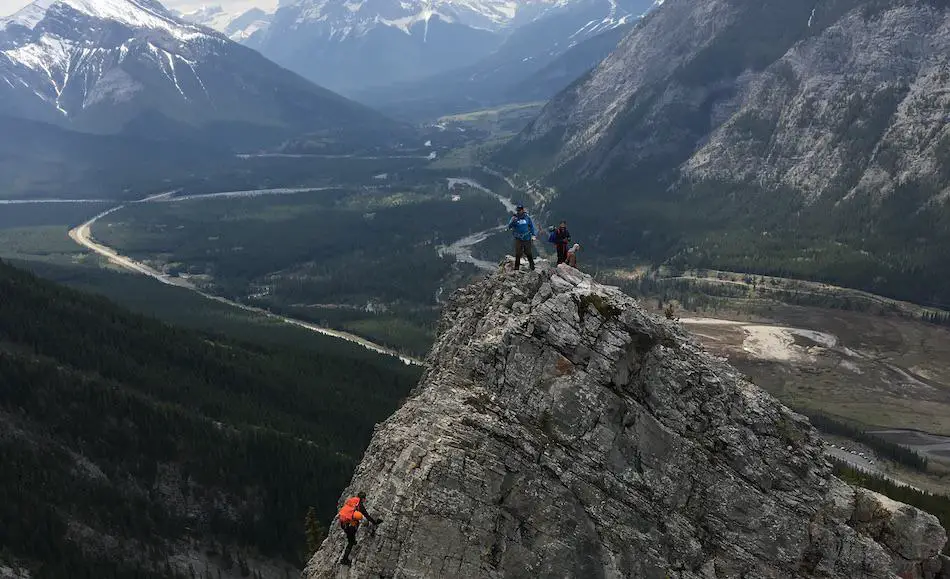
Scrambling is an amazing activity, but the grading system can be a little bit confusing. I wrote the following guide to teach you everything you need to know!
So, what are scrambling grades? Scrambles in North America are graded on the Yosemite Decimal System, ranging from Class 1 (Easy Hiking) to Class 5 (Rock Climbing). Scrambles in the UK are graded from 1-4, with 1 being moderately difficult and 4 being extremely difficult:
| US System | UK System | ||
| Class One | Easy walking; no hands on required. A normal hike. | Category One | A difficult hike, where hands-on scrambling will be required. |
| Class Two | Some hands-on scrambling required, with very little exposure. A fall will hurt. | Category Two | Difficult, varied scrambling across challenging terrain. A rope may be required. |
| Class Three | Hands-on scrambling with moderately difficult moves. A fall will break a bone. | Category Three | Tough scrambling in which a rope is almost always necessary. Dry conditions are essential. |
| Class Four | Technical scrambling on exposed terrain. A fall could result in death. | Category Four | An extremely difficult scramble requiring ropework and mountaineering skills. |
| Class Five | Technical rock climbing. Should not be attempted without a rope. |
Scrambling grades are based mainly on two factors: how difficult the moves are, and what the consequences will be if you fall. Other things, like the quality of rock or the length of the route, can also become a factor. Traditionally speaking, there are two main grading systems: the US one, which uses the Yosemite Decimal system, and the UK one. In this article, I break them both down in more detail, before talking a little bit about some other elements of scrambling.
Introduction to Scrambling

Scrambling is a sport that falls somewhere between hiking and rock climbing. When the terrain is too difficult to simply walk up, but not difficult enough to require technical gear like a rope and pitons, you are said to be ‘scrambling’.
In this way, scrambling covers a wide variety of difficulty levels, ranging from intense hikes to what could basically be considered easy free-solo climbs. Because of that, it’s important to know the grading system and make sure that you’re staying within your abilities.
As I said above, scrambling grades are usually comprised of two factors:
- How difficult the moves are (how likely am I to fall?)
- How exposed the moves are (what are the consequences if I fall?)
By balancing those two elements out, you arrive at your scrambling grade. For example, moderately difficult moves where there’s only 10 feet of tall danger might still be called class 2 scrambling on the YDS, whereas those same moves with 50 feet of air beneath them would be class 3 or 4.
Comparing the two Systems
For my entire life, I’ve used the YDS system for scrambling and, as of such, I don’t know that much about the UK grading system. Because of that, I can’t offer the most accurate account on how you can compare them.
However, from what I’ve gleaned online, I can say this: the UK system seems stiffer in the sense that a UK Category 4 scramble is much more difficult than a Class 4 YDS scramble. Keep this in mind if you’re an American who’s hopping across the pond to test yourself in Britain or the Scottish Isles.
US Grading System
So, without further ado, let’s get into the two systems! First up we have the US grading system, which is based around the Yosemite Decimal Scale (YDS). On the YDS, there are 5 levels of terrain:
- Class 1: Normal walking
- Class 2: More difficult walking, with your hands required at some spots
- Class 3: Sustained hands-on scrambling, with decent exposure
- Class 4: Difficult scrambling in no-fall territory
- Class 5: Technical rock climbing.
Class 1

What is it? Class 1 scrambling is essentially a steep walk. Your hands may be required to stabilize you from time to time, although hiking poles would probably work better.
How much danger are you in? Minimal danger. A fall might scrape you up, but you probably won’t get hurt beyond that.
Experience level needed: Basic balance and fitness is all that’s required for Class 1 scrambling. The terrain can be steep, but it won’t require and rock-climbing or scrambling moves.
Summary
Class 1 terrain isn’t really considered a scramble, but I’ve included it on this list all the same. This is just walking, albeit on steeper terrain than you might be used to. You may also have to contend with loose or unstable footing (like scree).
Basically, a class 1 scramble can be seen as a very difficult hike. You’ll probably have to do a lot of uphill, and your quads will be burning, but there won’t be any technical moves. As mentioned above, hiking poles can be a lifesaver for this type of scrambling.
Class 2

What is it? On class 2 scrambles, you need to use your hands to get up and around formations of rock.
How much danger are you in? If you fall, you’ll most likely hurt yourself and may break something.
Experience level needed: Most hikers or anyone who’s bouldered before will be able to perform fairly well on a class 2 scramble, as long as they’re with a more experienced party.
Summary
For those of us who love this sport, class 2 scrambling is where it starts to get fun.
Here, you need to use your hands to balance and pull yourself up on the terrain. Holds will be plentiful, large, and mostly stable, and there will be lots of places to put your feet. Fall risk will likely be minimal, although in some places you could be in danger of breaking a bone or worse.
Unfortunately, class 2 scramble is where the ambiguity starts when it comes to these grades. For example: you’re on extremely easy terrain, where you need your hands to balance but you can mostly just walk. However, if you were to slip and fall, you would slide down a gully and to your death. How do you rate that? Most people would call it a class 2 scramble, but anyone who wasn’t expecting to be in no-fall terrain would be surprised at the degree of exposure.
Because of that, it’s important to not underestimate this grade and to always respect the danger of scrambling for what it is. You should also make sure that you have the route-finding skills necessary to not end up in more challenging places.
Also: don’t believe me that the above scenario exists? Think again. Mount Yamnuska near Canmore has a section just like that.
Class 3
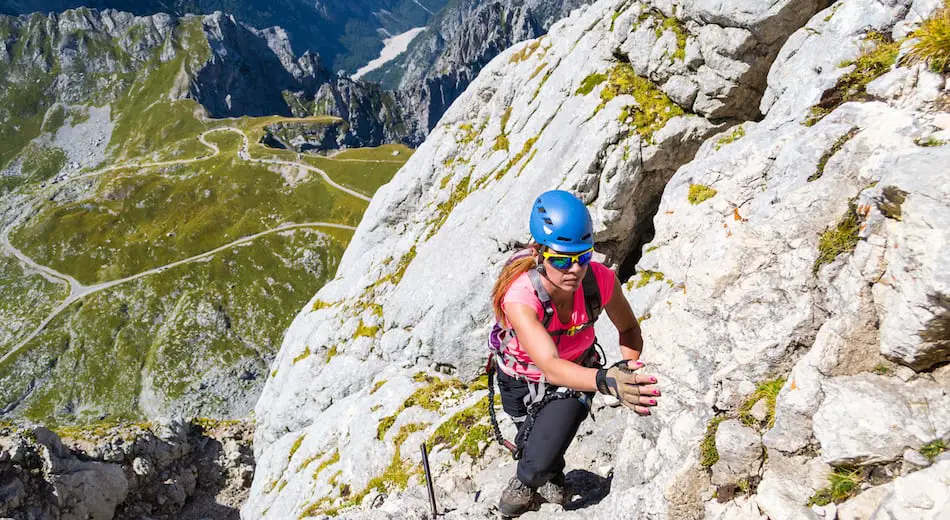
What is it? Longer, more difficult scrambling, in terrain where you definitely don’t want to fall.
How much danger are you in? Moderate to serious danger. If you fall, you’ll almost certainly break something.
Experience level needed: You should have comfortably completed at least five class 2 scrambles before you venture into class 3 terrain.
Summary
Class 3 scrambling means that you’re getting into more serious terrain where the consequences start to get real. On these routes, you’ll need to use your hands very often to make moderately challenging moves. Hand/footholds will be smaller, the rock will be looser, and routes will be harder to find.
To comfortably scramble on class 3, it can help if you have a little bit of rock-climbing experience; this will teach your body how to move more naturally. You should also have good route-finding skills, proper footwear, and maybe even some kind of emergency beacon in case someone takes a fall.
Class 3 scrambles are also where your mentality starts to play an extremely important role. Not everyone is cut out for looking down and seeing 40 feet of air beneath them, knowing that all that’s keeping them attached to the rock is their own two hands. Getting scared can make your scramble more dangerous; fear leads to shakiness, bad climbing, and accidents.
Accidents on class 3 scrambles should be avoided at all cost. You’ll break something at a minimum if you fall, and it’s not out of the realm of possibility that you could die.
Thankfully, the handholds are often solid enough that falling is usually fairly avoidable. Still, when you’re on a class 3 scramble, you need to be constantly alert. Every hold should be tested before you trust it with your weight, and every move should be deliberate.
Pro tip: going backwards is always harder. Don’t scramble up something you can’t then scramble down, or you may need to get helicoptered off of the route (like I did).
Class 4

What is it? Challenging moves on exposed terrain, sometimes combined with poor rock quality.
How much danger are you in? Severe danger. A fall in these areas will almost certainly result in death.
Experience level needed: Lots. I would suggest having 2-3 seasons of experience on class 3 routes before you venture onto 4th class scrambling.
Summary
Mommas, don’t let your babies grow up to be 4th class scramblers.
Toeing a very precarious line between scrambling and free solo climbing, 4th class scrambling is for the veterans of the sport. These routes require difficult moves on extremely exposed terrain, where a fall will most likely kill you.
To scramble class 4 routes, you need:
- Rock climbing experience
- Steely nerves
- Proper equipment (good boots are a must; a helmet is recommended)
- Excellent route-finding skills
- Several years of experience.
I cannot stress enough the dangerous of these routes, but I’ll try: When you’re fourth class scrambling, one mistake could kill you.
There’s really not much else I can say, except to please not rush yourself to get to this point in your scrambling career. As someone who’s been in the sport for 5 years now and is just starting to get comfortable on this type of terrain, take it from me: the mountains aren’t going anywhere. Take your time and make sure that you know what you’re doing before you venture out onto a 4th class scramble.
Class 5

What is it? Technical rock climbing on vertical or near-vertical cliff faces.
How much danger are you in? With the proper equipment, you’re in very little danger. If you have no equipment, you’re in a lot (a LOT) of danger.
Experience level needed: Enough experience to know how to belay and maybe place gear if you’re on a trad route.
Summary
On the YDS, 5th class terrain is technical rock climbing. This is why rock-climbing routes are graded as 5.7, 5.11, etc.
For this reason, you shouldn’t attempt to climb on this stuff unless you have the proper equipment and training to do so. Free soloing does exist, and there are people out there who love it, but it’s not an activity that I recommend getting into.
UK Grading System
The UK system is much different from the American one in terms of the difficulty expressed (hence why I said earlier that there’s no definitive ‘exchange rate’ between the two grades). On this system, each category consists of a wider variety of routes, and the jumps between categories are much more extreme.
In fact, I would argue that the upper end of the UK grading system includes routes that are more similar to alpine climbs than they are to true scrambles. Because of that, you should be careful about what you get yourself into when you’re using this grading system.
The UK scrambling index has 4 difficulty levels:
- Category 1: A challenging hike with some moderate scrambling sections
- Category 2: A difficult scramble over challenging terrain, with some sections of extreme exposure
- Category 3: Sustained, difficult scrambling. You will almost certainly need a rope to cross some sections.
- Category 4: An alpine/mountaineering route. Failure to bring a rope will necessitate free soloing.
Category 1
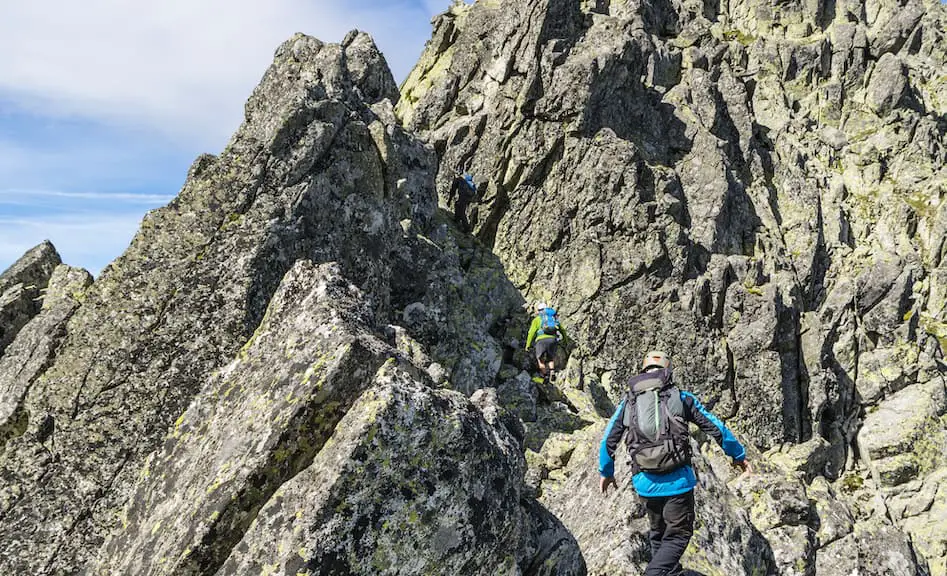
What is it? UK category 1 scrambles are roughly equivalent to class 2/3 terrain on the YDS. You have to combine hiking with sections of moderate scrambling.
How much danger are you in? Depending on the route, a fall could result in broken bones
Experience level needed: You should be a very competent hiker, and should have a more experienced friend with you.
Summary
The British Mountaineering Council describes a category 1 scramble as ‘essentially an exposed walking route’. It then goes on to say that ‘despite some knee trembling sections… [classic category 1 scrambles] can be attempted without the likes of rope or equipment’.
I would say that a category 1 scramble is one in which your hands will be required to move across some terrain, and the worst of the difficult sections will be mostly avoidable. You may still have to content with either exposure or technical scrambling, but rarely will you have to deal with both at the same time.
Category 2
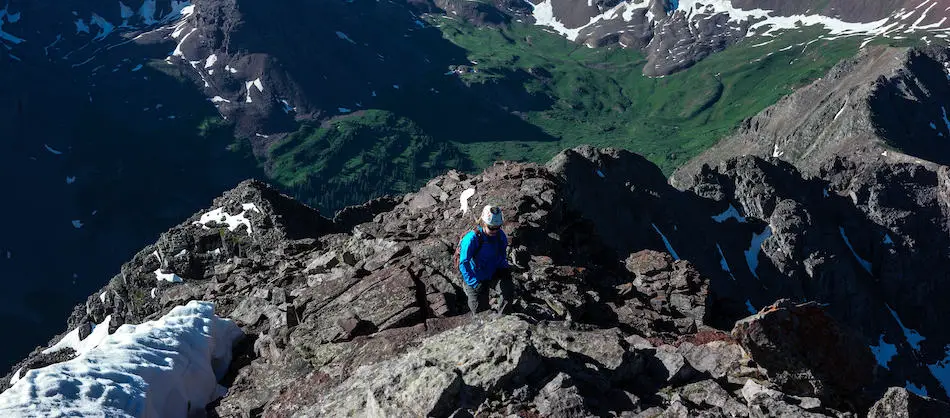
What is it? A blurry space between hard scrambling and easy rock climbing.
How much danger are you in? If you’re not absolutely confident in your abilities, you’ll want a rope.
Experience level needed: You should either be a hardened scrambler (several seasons of scrambling on class 4 YDS terrain) or have experience trad climbing.
Summary
This is what I mean when I say that the British system gets way harder, way faster.
A category two scramble is basically an easy alpine route. You either need an extremely strong head game to not get nervous on exposed sections, or you can expect to have to rope up. It’s quite possible that you’ll be moving between sections of easy scrambling and sections of rock climbing in which protection is needed.
A category 2 route is probably the highest level of difficulty that anyone, save for a free soloist, could expect to complete without a rope. However, unless you’re extremely experienced, I wouldn’t recommend trying this.
Category 3
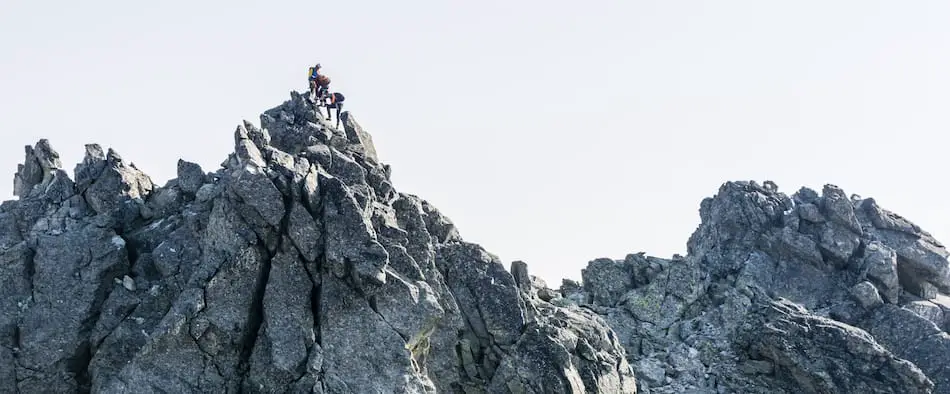
What is it? Sections of easy climbing separated by sections of moderate scrambling.
How much danger are you in? If you don’t bring a rope, you have a very good chance of falling to your death.
Experience level needed: You should have several category 2 scrambles, as well as some easy multipitch rock climbs under your belt before you wander onto this type of scramble.
Summary
Class 3 scrambling is essentially easy rock climbing, with some sections that are more akin to class 2/3 YDS terrain. Expect to have to rope up frequently, and in some places you’ll have to perform fairly challenging rock climbing moves.
In between the sections for which you need a rope, expect to still be faced with moderate to challenging scrambling as you pick your way along. Good route-finding skills are essential to make sure that you don’t get off-track.
Category 4
What is it? A challenging alpine route requiring a variety of different skills including placing protection and potentially traveling on snow.
How much danger are you in? Moderate to extreme danger for the entire time that you’re on the route.
Experience level needed: You should be an experienced mountaineer before you try your luck on one of these routes, and you should make sure to travel with equally experienced partners.
Summary
A category 4 scramble is more akin to alpinism than it is to traditional scrambling. You’ll need a rope, protection, good trad climbing skills, and maybe even snow gear to make it across one of these routes.
Before you try a category 4 scramble, you should make sure that you have both the physical and mental prowess to do so safely. Routes at this level require not only good rock-climbing skills, but also good scrambling skills to move between the sections for which you’ll be roped up.
Factors that Can Influence Grades
I said earlier that there are two main things that influence grades: the technicality of the moves, and the exposure.
What Are Technical Moves?

‘Technical moves’ are one where you’re off-balance or in a precarious position and you need to use hand/footholds in the rock to stabilize yourself. Basically, it’s a term for what you have to do with your body when normal walking motions won’t get you through a section of terrain.
The more technical the moves on a route are, the more difficult they are; the more difficult a move is, the more likely you are to fall while performing it.
A good way to ensure that you don’t fall while performing these moves is to take up climbing or bouldering as a hobby. These sports will teach you how your body moves in certain situations, and they’ll help you feel more confident when you’re scrambling.
What Is Exposure?
Exposure essentially means how far you are from the ground. In other terms, it can be seen as a measure of how far you would fall before you hit the ground, if you were to let go while scrambling.
Obviously, the higher the exposure, the higher the danger of the route; the two can be seen as almost synonymous. If you want to take up scrambling, you should be comfortable being at least 20 feet off the ground without getting nervous, as this is the minimum likely distance you’ll be exposed to on a scramble.
In terms of exposure, some rules of thumb apply:
- For distances of 10 feet or less, you likely won’t be hurt in a fall.
- For distances of 10-20 feet, a fall will hurt, and you might break something.
- For distances of 20-50 feet, you’ll almost certainly break something, and you might die.
- For distances greater than 50 feet, death is a highly potential outcome of any fall.
Other Factors
Additionally, there are other factors that should be taken into consideration when you’re trying to judge whether or not a route is within your difficulty level:
Rock Quality
The ability to grab a handhold and know that it’s going to support your bodyweight is invaluable when you don’t have a rope on. Good quality rock can make any scramble infinitely easier; in the same way, bad quality rock can make your scramble at least one grade more difficult.
Having to contend with loose or crumbling rock makes this already dangerous sport much more so. The constant threat of not being able to fully trust your hand/footholds increases the risk that you’ll trust your weight on the wrong thing and fall to your death.
Additionally, bad rock makes it harder to focus mentally, because you can start second-guessing yourself. Personally, I know that my hands get sweaty whenever I’m faced with challenging scrambling on tough terrain.
Conditions

When talking about conditions, there are two things to concern yourself with: weather conditions and route conditions.
Weather conditions are what’s going on around you at that given time. If it’s raining, or extremely cold, or super windy, it can become harder to hold onto the rock. You risk slipping and falling at any given moment.
Additionally, scrambling often takes place in mountainous environments, and lightning is a real threat. There’s no worse feeling than being on an exposed ridge, watching a thick bank of clouds roll in, knowing that you have no easy way down. You should do your best to never get caught in that type of scenario.
Route conditions are the conditions of the path that you need to take. Dry rock is highly preferable for scrambling, but unfortunately, rarely will you find it for the entire route. You should be on the lookout for:
- Snow patches: Especially in the Canadian Rockies (where I live), snow can linger for an entire season without melting. One 20-foot patch of snow in the wrong spot can be all that is required to turn you around before you reach the summit.
- Wet rock: This makes your hands and feet less secure, increasing the risk of a fall.
- Changes in the route: Nature has a way of shifting over time. Rocks break off, landscapes are changed, markers get buried, and sometimes entire mountaintops can be blown off by lightning. Because of this, you should make sure to real the most p-to-date trail report that you can (I personally use AllTrails and I love it).
